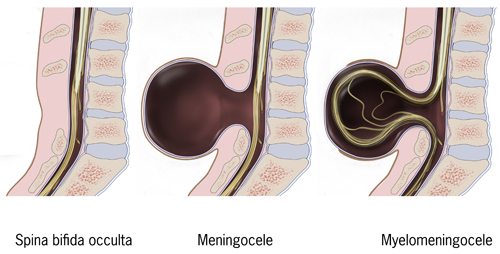Spina Bifida
Spina bifida (SB; /ˌspaɪnə ˈbɪfɪdə/, Latin for 'split spine') is a birth defect characterised by the incomplete closing of the spine and the membranes around the spinal cord during early pregnancy. There are three main types: spina bifida occulta, meningocele, and myelomeningocele. Meningocele and myelomeningocele may collectively be referred to as spina bifida cystica. The most common location is the lower back, although it may occur in the middle back or neck in rare cases.

Types
Spina Bifida Occulta
Occulta is the mildest form of spina bifida where the outer part of some vertebrae is not completely closed. The splits in the vertebrae are so small that the spinal cord does not protrude. Many people are asymptomatic, and the condition is often discovered incidentally.

Meningocele
Meningocele is a rare form where the meninges herniate between the vertebrae, forming a fluid sac. The nervous system remains undamaged, so long-term health problems are unlikely.

Myelomeningocele
Myelomeningocele (MMC), also known as meningomyelocele, is the most severe form, where the spinal cord and meninges protrude through an opening in the spine. It is associated with significant complications such as poor ability to walk, bladder and bowel dysfunction, and hydrocephalus.

Signs and Symptoms
Physical Problems
Physical signs may include leg weakness and paralysis, orthopaedic abnormalities like club foot and scoliosis, bladder and bowel control problems, and skin irritations. Many children with spina bifida also have a latex allergy.
Neurological Problems
Neurological complications often include Arnold Chiari II malformation and hydrocephalus, affecting up to 90% of those with myelomeningocele. There may also be abnormalities in the cerebellum, corpus callosum, and cortex, impacting communication between brain hemispheres and potentially leading to cognitive and executive function deficits.
Causes
Spina bifida is caused by a combination of genetic and environmental factors. Genetic predisposition accounts for 60-70% of cases. Other risk factors include folic acid deficiency, certain antiseizure medications, obesity, and poorly managed diabetes.
Pathophysiology
Spina bifida occurs when the neural tube fails to close properly during early embryonic development. Medications, diabetes, obesity, and genetic factors can increase the risk.
Prevention
While there is no single cause of spina bifida, dietary supplementation with folic acid before and during pregnancy can reduce its incidence. Fortified wheat flour has been credited with preventing thousands of neural tube defects annually.
Screening
Prenatal screening for spina bifida includes maternal serum alpha-fetoprotein (MSAFP) tests, ultrasound, and amniocentesis. Ultrasound can detect open spina bifida, while elevated AFP levels suggest a higher risk.

Treatment
Surgery
Standard treatment involves surgical closure of the spinal defect after birth to prevent further damage and infection. A shunt may be installed for hydrocephalus to drain excess cerebrospinal fluid.
Prenatal Surgery
Prenatal surgical options include open foetal surgery and fetoscopic surgery. These aim to repair the defect before birth, but come with risks such as preterm birth and uterine scarring.
Multidisciplinary Care
Management involves periodic evaluations by specialists, including physiatrists, orthopedists, neurosurgeons, neurologists, urologists, and therapists.
Transition to Adulthood
Transitioning to adult healthcare can be challenging due to the need for coordinated care among multiple specialists. Adolescents should begin preparing for this transition around ages 14-16.
Epidemiology
Rates of spina bifida vary significantly by country and ethnicity. In developed countries, it occurs in about 0.4 per 1000 births, with higher rates among Caucasians and lower rates among Asians and people of African descent.
History and Research
Spina bifida has been known since ancient times, with early descriptions by Persian physician Al-Razi. Recent advancements include prenatal surgical techniques and the Management of Myelomeningocele Study (MOMS), which highlighted the benefits of prenatal surgery.
Self-assessment MCQs (single best answer)
What is the mildest form of spina bifida?
Which of the following is NOT a type of spina bifida?
Which type of spina bifida involves the spinal cord and meninges protruding through an opening in the spine?
What is the most common location for spina bifida to occur?
Which prenatal screening test for spina bifida measures elevated alpha-fetoprotein levels?
Which of the following is a common physical sign of spina bifida?
What percentage of spina bifida cases are thought to be due to genetic predisposition?
Which neurological complication is often associated with myelomeningocele?
What dietary supplement is recommended to help prevent spina bifida?
Which study highlighted the benefits of prenatal surgery for spina bifida?
Dentaljuce
Dentaljuce provides Enhanced Continuing Professional Development (CPD) with GDC-approved Certificates for dental professionals worldwide.
Founded in 2009 by the award-winning Masters team from the School of Dentistry at the University of Birmingham, Dentaljuce has established itself as the leading platform for online CPD.
With over 100 high-quality online courses available for a single annual membership fee, Dentaljuce offers comprehensive e-learning designed for busy dental professionals.
The courses cover a complete range of topics, from clinical skills to patient communication, and are suitable for dentists, nurses, hygienists, therapists, students, and practice managers.
Dentaljuce features Dr. Aiden, a dentally trained AI-powered personal tutor available 24/7 to assist with queries and provide guidance through complex topics, enhancing the learning experience.
Check out our range of courses, or sign up now!


